Pebble Time review: an underdog among smartwatches

For two years, Pebble was the smartwatch company to beat. In 2012, it raised over $10 million on Kickstarter for its simple, monochrome e-paper wristwatch, putting itself and the crowdfunding site on the map. But things move quickly in the technology world. Google has since come out with Android Wear, prompting a slew of smartphone companies to suddenly turn into watchmakers. Not to be outdone, Apple joined the fray as well, positing its own wearable as a timepiece premium enough for high-end boutiques. So when Pebble debuted the Time, its second-generation $199 smartwatch, on Kickstarter three months ago, it was facing much stiffer competition. Surprisingly, that too made crowdfunding history, raising more than $20 million in just over a month. Did 78,471 backers make the right decision? I attempt to find out.
Hardware
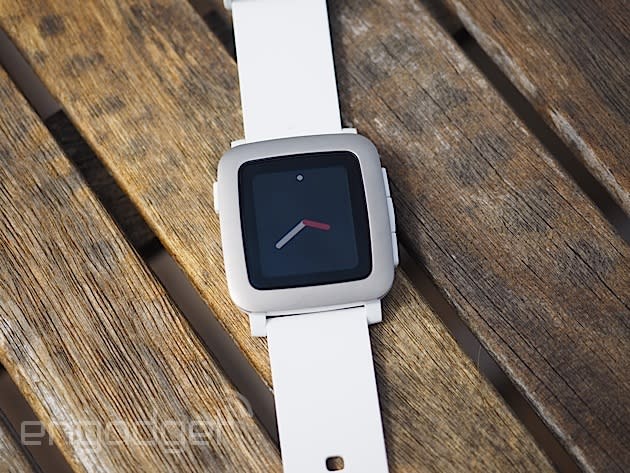
If you're looking for a stylish fashion-forward smartwatch that can double as a luxury timepiece, look elsewhere. With its square display, polycarbonate shell and wide silicone bands, the Pebble Time is decidedly more geek than chic. Yet, the Time has a charm all its own, with a casual, sporty look that I rather like. Sure, it'll probably look out of place at a fancy cocktail party, but for a simple everyday watch, I think it's alright.
Additionally, while most smartwatches tend to be oversized and bulky for my slender wrists, the Time's 40.5 x 37.5mm case isn't too big or too small; it fits me just right. It's a hair thinner than its predecessor at 9.5mm (the original Pebble was 11.5mm thick) and has a slight bend to better hug the curvature of the wrist. The stainless steel border surrounding the display also gives it a touch of class that I really appreciate -- it's certainly better than the original's all-plastic styling.
The real differentiator between the Time and the original Pebble, however, is the display -- it's now in color. But instead of going with an OLED panel, Pebble opted for a color e-paper display. Yes, this means that the screen isn't quite as bright and luminous as the Apple Watch and most Android Wear devices. The colors of e-paper are also a lot more muted than what you would see on an OLED display. But e-paper gives the Time a few significant advantages.

For one thing, the display is on all the time; there's no need to press a button or flick your wrist to see what time it is. The 2.5D Gorilla Glass display is also very readable even under really bright sunlight, which isn't what we can say about some of the other smartwatches. If you do want the display to be brighter, there's an LED backlight that you can turn on momentarily, but there's unfortunately no backlight timer to make it last longer than a few seconds. The biggest advantage, though, is battery life. While the Apple Watch and Android Wear devices might manage a day or two on a charge, the Time is slated to last up to seven days before running out of juice.
Unfortunately, however, the Time has a very thick bezel, which is made even worse by the aforementioned stainless steel frame. As a result, the 1.25-inch e-paper display looks positively diminutive on the Time's watch face. Most Pebble apps are made for that screen size, so I understand the rationale for it, but it just seems like a lot of wasted space.
As for the rest of the watch's controls, they're pretty similar to the original Pebble -- that's right, there's no touchscreen interface. Look around and you'll find a back button on the left, along with up, down and select buttons on the right. The up and down buttons lead to "Past" and "Future" spots in Pebble's new timeline interface (more on this later), although you can also map them as quick-launch shortcuts to certain applications if you press and hold down on them. The buttons are raised above the surface and are really tactile; I could find them just by feeling around. It doesn't seem like much, but I really appreciate that I could press a button to dismiss my alarm without even looking at the watch. As a bonus, they also have some nice "give" when pushed.

Flip the watch around and you'll notice a couple of metal pins that attach to a proprietary magnetic charging cable. Keep in mind that you won't be able to use the charging cable from the original Pebble with the Time; you'll simply have to use the new one. Aside from acting as charging pins, the magnetic dock will also work as a smart accessory port for upcoming "smartstraps" that add additional functionality to the watch. They're not available just yet, but a few of the proposed ones add GPS, a heart rate monitor and NFC. While I wasn't able to test these smartstraps, the idea itself is intriguing: Imagine a smartwatch that gets better over time as new smartstraps emerge. This could potentially make the Pebble Time the first-ever futureproof smartwatch.
Also on the rear of the watch are a couple of quick-release triggers so you can easily swap straps, which is a good thing because the Time has a standard 22mm lug that is compatible with a wide variety of third-party straps. Other notable hardware specs include an accelerometer (if you like, you can enable the backlight whenever you lift your wrist), a vibrating motor for alerts, a compass, a microphone for voice commands (more on this later) and an ambient light sensor that adjusts the brightness of the LED backlight depending on your surroundings. The Pebble Time is also water-resistant up to 30 meters. And, of course, it has Bluetooth 4.0 LE for connecting to your phone.
Software
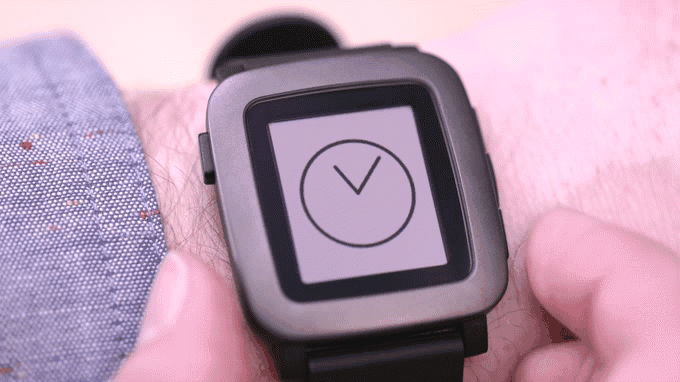
Just like with the original Pebble, you'll need to pair the watch with a phone in order for it to work. In order to do that, you'll need to download the Pebble Time app, which is available on both Android and iOS. Once that's done, simply go through the instructions of pairing your phone to the watch, and then you're ready to start customizing. The software lets you add watch faces and a variety of apps, just like before. Indeed, the Pebble Time is backward-compatible with nearly 6,500 apps that are already in the Pebble app store.
But the similarities end there. Pebble didn't just change up its hardware with the Time. Oh no, it actually created a whole new operating system for it as well. Simply called Timeline, Pebble's new watch interface is based around the concept of, well, time. All your app notifications, reminders, events and news are now laid out in chronological order. Press the up button and you'll see items like calendar events and sports scores from a couple hours ago. Press it again and you'll see items from yesterday, like your total step count if you have a pedometer app installed. Inversely, pressing the down button will give you a peek at future events -- say, an upcoming appointment or the weather forecast.
The idea behind this timeline metaphor is that you no longer need to launch an app to find out desired info. Simply go into the Pebble Time app on your phone and select the "Timeline pins" toggle to "pin" that particular app. So if you pinned the ESPN app, for example, you would see the scores of last night's games if you scrolled into the "Past" (you'd need to select your favorite teams so that it knows which games to keep track of). You'd also see the time of tomorrow night's games if you scrolled into the "Future."
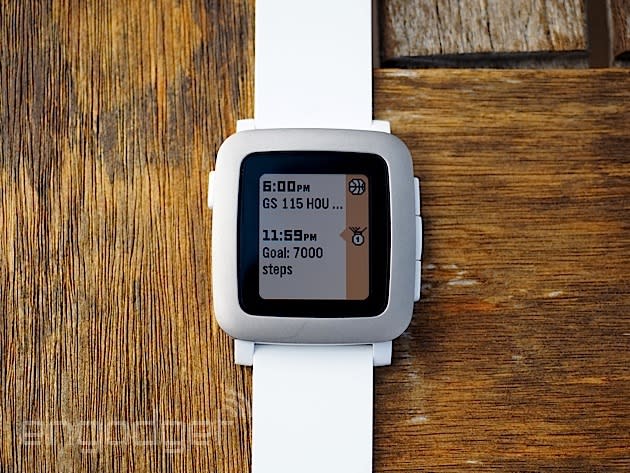
But that doesn't mean you won't still have access to apps. Selecting the center button from the main watch screen opens up the App Menu, which essentially lists all of the apps that you've installed. The default apps include Notifications, Music, Alarms and Watchfaces. Notifications is simply a list of all of your recent phone notifications; Music is a remote control for the music player on your phone; Alarms lets you set a vibrating watch alarm (duh); and Watchfaces is simply a list of different watch faces that you've installed and can choose from. You can also access the settings menu from the app tray, which lets you set options like your time zone, choose which app you want to use for activity tracking (more on this later) and enable or disable vibrating alerts. I especially like the ability to set a Do Not Disturb time schedule so that your watch doesn't go crazy with notifications in the middle of the night.
As far as the number of apps that you can install, well, that depends. According to Pebble, the Time is capable of storing more than 50 apps and watch faces -- it depends on how large each app/watch face is. If you install more than the watch can hold, it'll just offload the apps you don't use as much. If you do want to call up those old apps, it will simply reload them over Bluetooth when requested. The idea is akin to storing your music on the cloud instead of on your device. That said, I probably wouldn't install more than a dozen or so; scrolling down the long list of apps in the app tray gets tiresome.
Of course, you can get all kinds of apps in the appstore, from funny watch faces (my favorite is the Nyan Cat one that actually shows an animated, rainbow Pop Tart cat flying through space whenever the watch is activated) to activity trackers. There is one caveat, however: You can only really have one activity-tracking app at a time. This means that if you have three similar apps, you can only assign one of them to be the one that tracks your steps.
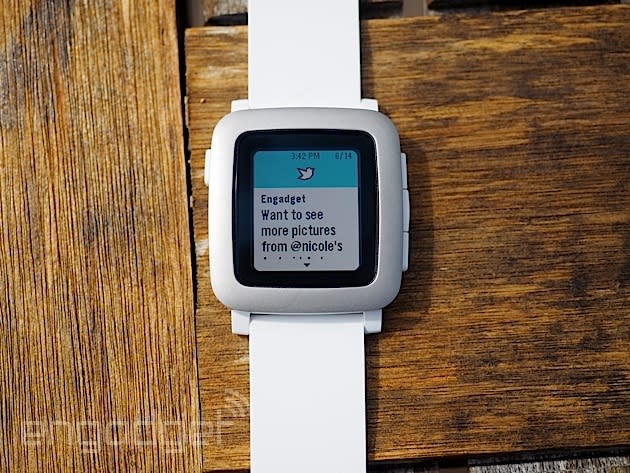
As I alluded to earlier, there are a few big-name apps in the store already. My favorites include ESPN (so that I can keep track of how the San Francisco Giants are doing), an app called Transport that lets me hail an Uber from my wrist and FitCat, which is sort of a Tamagotchi game and an activity tracker all-in-one (the more you walk, the happier the cat becomes).
Like other smartwatches, the Time also lets you receive text messages. As for what you can do with those, well, that depends on which OS you use. Due to iOS app restrictions, you can't really do much with messages aside from dismissing them. If you're on Android, however, you're able to reply to a message in a number of ways -- you can either choose from a list of canned responses, one of many emojis or decide to respond by voice. If you select voice, you can then simply speak your reply and the watch will translate your voice to text as best it can. I only tested this on a few occasions, but it was pretty accurate most of the time. According to a company rep, Pebble is working hard to enable voice replies (to email at least) and note-taking on iOS as well.

About those voice commands -- they're really pretty limited to just replies and notes. You won't be able to use them for Google Now queries or Siri commands. Pebble says that's intentional, because it doesn't believe those commands really work all that well. But it seems a bit like an oversight to us that you wouldn't at least offer it as an option.
A final note about software before I move into the next section: Though it's not a specific feature, per se, I really enjoy the touches of animations and transitions that the new interface offers. Dismissing a notification reveals a puff of smoke as it disappears; removing a pinned timeline item shows a graphic of a skull before it's gone; and adding a new watch face prompts an animated star. Each notification also has its own unique animation and art style as it pops up. Instagram has a camera icon; Gmail has an envelope; and so forth. There are probably more that I haven't noticed yet. It might seem a little cartoony if you're used to the finesse of Android or Apple's Watch OS, but it's these small bits of whimsy that I find endearing.
Performance and battery life

The Pebble Time is a fairly basic smartwatch -- it's not trying to be a smartphone shoehorned into your wrist. As such, the performance is pretty snappy -- a stark contrast to the Apple Watch, for example, which has been criticized for being a bit sluggish. There's not much noticeable lag when shifting through menus and changing watch faces only takes a second or so. Whenever I altered some settings on the Pebble Time app, I saw those changes reflected almost immediately on the watch.
I only received the Pebble Time a few days ago, and the battery test is, well, it's still ongoing. After about three days of constant use, it's currently at 40 percent battery life. And that's with all my notifications turned on -- even email. I get literally hundreds of emails every day, so this is an impressive feat. I suspect that lighter use will make it last longer, but even so, the battery life is pretty impressive.
The competition
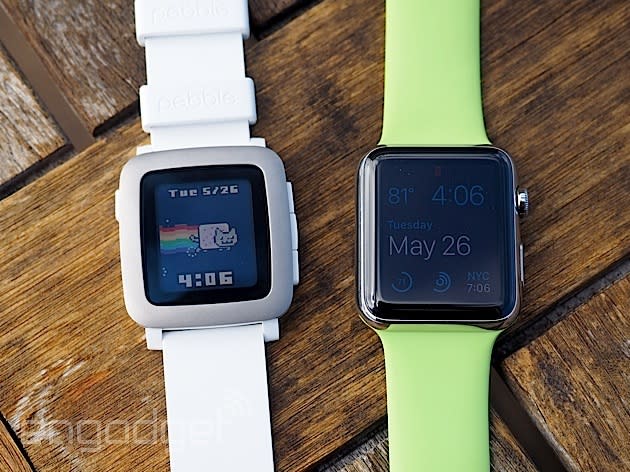
Style-wise and feature-wise, the Pebble Time doesn't quite compare to most modern smartwatches. It doesn't have a touchscreen; it doesn't have NFC support; it doesn't have a heart rate monitor; and it doesn't have GPS. Which is why the Pebble Time's price is problematic -- it retails for close to $200. For that same money, you can get a really nice ASUS ZenWatch that's high on style and function. For about $20 less, you can get the star of last year's Google I/O, the Moto 360, which has seen a number of improvements since its debut (and who knows, we might see a successor at this year's I/O). And if you're an Apple fan, well, you have the option of the Apple Watch, which will set you back a cool $349 just for the entry-level Sport model.
The big trump card that the Pebble Time has, then, is its battery life -- most of these other watches last about a couple days at most -- that always-on display, its compatibility with both Android and iOS, and its smart-strap potential. The ability to tack on additional hardware features as time goes by is pretty powerful stuff, and could be the ace up Pebble Time's sleeve. And hey, if you're looking for a sexier-looking watch instead, that higher-end Pebble Time Steel ($299) is just around the corner.
Wrap-up
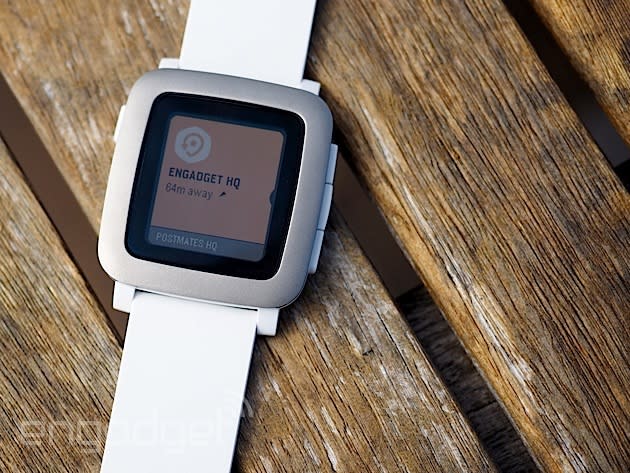
No, the Pebble Time won't win any fashion contests with its toy-like design and cutesy animations. And no, it won't win over those who yearn for tons of high-end features in their wearables. But if your idea of a smartwatch is that it should be more of a watch than a smartphone accessory, then the Pebble Time could be it. Its always-on display, long battery life and compatibility with both Android and iOS are attributes that most other smartwatches can't match. The Timeline interface puts your events and app notifications in easy-to-access, chronological order, reducing the need to launch apps every time you want information. And the ability to swap out modular smartstraps means the Time could have far greater functionality than its rivals over the long term. The Pebble Time certainly isn't for everyone, but if you're tired of the hubbub over Android Wear and Apple Watch and want a decent alternative, then it could be well worth your time.
[Image credit: GIF courtesy of Pebble]










































































